

Big Blue Liriope (Liriope muscari 'Big Blue') grows to form a dense, dark green, grass-like groundcover in medium to full shade. As one of the very best "dry-shade" plants, it has environmental and economic traits that can help conserve water and lower your water bill! Plantings can thrive for decades if in the right spot; there is no such thing as overcrowding for Liriope. When planted in mass, growth is slow at first but eventually a cake-like rhizome system will form and completely smother out any weeds and compete well with trees for water and nutrients. Even under the most hostile conditions such as huge silver maple and pin oak trees, liriope not only survives but thrives. While Big Blue Liriope can tolerate full sun, they prefer part to full shade. Sun burning is possible with temperatures over 100° and there are better plants to use in hot areas. Liriope has no insect or disease problems, will survive droughts, short-term floods and cold winters. In the winter, it will stay green until 0 degrees F and be completely evergreen some winters. Liriope also thrives in summer with the worst heat and humidity even in the Southeast and Southwest! Liriope is tolerant of a wide range of soil types but prefers clay/loam and will display best growth in fertile soils with average water but extremely drought tolerant in shaded areas! For the home garden, the species spreads slowly so you shouldn't leave very much room in-between Liriope plants or you will be waiting many years for the patch to fill in. Weeds can be a problem in that open area between plants if spacing is too wide. We recommend 12-18" spacing for a larger area. The only problem we have seen is a mysterious crown-rot disease in well-irrigated gardens. This liriope (Liriope muscari 'Big Blue') does not spread very quickly or much at all compared to Spreading Liriope / Monkey Grass (Liriope spicata) This is a real trooper for the dry shade garden!
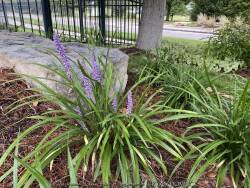

Classic Blue Clump-forming Liriope (Liriope muscari 'Classic Blue' / 'Ingwersen') grows to form a dense, dark green, grass-like groundcover in medium to full shade. As one of the very best "dry-shade" plants, it has environmental and economic traits that can help conserve water and lower your water bill! Plantings can thrive for decades if in the right spot; there is no such thing as overcrowding for Liriope. When planted in mass, growth is slow at first but eventually a cake-like rhizome system will form and completely smother out any weeds and compete well with trees for water and nutrients. Even under the most hostile conditions such as huge silver maple and pin oak trees, liriope not only survives but thrives. While Big Blue Liriope can tolerate full sun, they prefer part to full shade. Sun burning is possible with temperatures over 100° and there are better plants to use in hot areas. Liriope has no insect or disease problems, will survive droughts, short-term floods and cold winters. In the winter, it will stay green until 0 degrees F and be completely evergreen some winters. Liriope also thrives in summer with the worst heat and humidity even in the Southeast and Southwest! Liriope is tolerant of a wide range of soil types but prefers clay/loam and will display best growth in fertile soils with average water but extremely drought tolerant in shaded areas! For the home garden, the species spreads slowly so you shouldn't leave very much room in-between Liriope plants or you will be waiting many years for the patch to fill in. Weeds can be a problem in that open area between plants if spacing is too wide. We recommend 12-18" spacing for a larger area. The only problem we have seen is a mysterious crown-rot disease in well-irrigated gardens. This liriope (Liriope muscari 'Classic Blue' / 'Ingwersen') does not spread very quickly or much at all compared to Spreading Liriope / Monkey Grass (Liriope spicata) This is a real trooper for the dry shade garden!
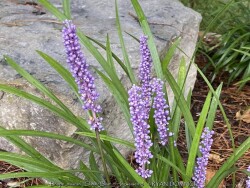

Classic Blue Clump-forming Liriope (Liriope muscari 'Classic Blue' / 'Ingwersen') grows to form a dense, dark green, grass-like groundcover in medium to full shade. As one of the very best "dry-shade" plants, it has environmental and economic traits that can help conserve water and lower your water bill! Plantings can thrive for decades if in the right spot; there is no such thing as overcrowding for Liriope. When planted in mass, growth is slow at first but eventually a cake-like rhizome system will form and completely smother out any weeds and compete well with trees for water and nutrients. Even under the most hostile conditions such as huge silver maple and pin oak trees, liriope not only survives but thrives. While Big Blue Liriope can tolerate full sun, they prefer part to full shade. Sun burning is possible with temperatures over 100° and there are better plants to use in hot areas. Liriope has no insect or disease problems, will survive droughts, short-term floods and cold winters. In the winter, it will stay green until 0 degrees F and be completely evergreen some winters. Liriope also thrives in summer with the worst heat and humidity even in the Southeast and Southwest! Liriope is tolerant of a wide range of soil types but prefers clay/loam and will display best growth in fertile soils with average water but extremely drought tolerant in shaded areas! For the home garden, the species spreads slowly so you shouldn't leave very much room in-between Liriope plants or you will be waiting many years for the patch to fill in. Weeds can be a problem in that open area between plants if spacing is too wide. We recommend 12-18" spacing for a larger area. The only problem we have seen is a mysterious crown-rot disease in well-irrigated gardens. This liriope (Liriope muscari 'Classic Blue' / 'Ingwersen') does not spread very quickly or much at all compared to Spreading Liriope / Monkey Grass (Liriope spicata) This is a real trooper for the dry shade garden!


Royal Purple Liriope (Liriope muscari 'Royal Purple') grows to form a dense, dark green, grass-like groundcover in medium to full shade. As one of the very best "dry-shade" plants, it has environmental and economic traits that can help conserve water and lower your water bill! Plantings can thrive for decades if in the right spot; there is no such thing as overcrowding for Liriope. When planted in mass, growth is slow at first but eventually a cake-like rhizome system will form and completely smother out any weeds and compete well with trees for water and nutrients. Even under the most hostile conditions such as huge silver maple and pin oak trees, liriope not only survives but thrives. While Big Blue Liriope can tolerate full sun, they prefer part to full shade. Sun burning is possible with temperatures over 100° and there are better plants to use in hot areas. Liriope has no insect or disease problems, will survive droughts, short-term floods and cold winters. In the winter, it will stay green until 0 degrees F and be completely evergreen some winters. Liriope also thrives in summer with the worst heat and humidity even in the Southeast and Southwest! Liriope is tolerant of a wide range of soil types but prefers clay/loam and will display best growth in fertile soils with average water but extremely drought tolerant in shaded areas! For the home garden, the species spreads slowly so you shouldn't leave very much room in-between Liriope plants or you will be waiting many years for the patch to fill in. Weeds can be a problem in that open area between plants if spacing is too wide. We recommend 12-18" spacing for a larger area. The only problem we have seen is a mysterious crown-rot disease in well-irrigated gardens. This liriope (Liriope muscari 'Royal Purple') does not spread very quickly or much at all compared to Spreading Liriope / Monkey Grass (Liriope spicata) This is a real trooper for the dry shade garden!
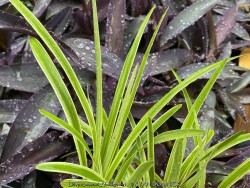

Variegated Liriope (Liriope muscari 'Variegata') grows to form a dense, dark green, grass-like groundcover in medium to full shade. As one of the very best "dry-shade" plants, it has environmental and economic traits that can help conserve water and lower your water bill! Plantings can thrive for decades if in the right spot; there is no such thing as overcrowding for Liriope. When planted in mass, growth is slow at first but eventually a cake-like rhizome system will form and completely smother out any weeds and compete well with trees for water and nutrients. Even under the most hostile conditions such as huge silver maple and pin oak trees, liriope not only survives but thrives. While Big Blue Liriope can tolerate full sun, they prefer part to full shade. Sun burning is possible with temperatures over 100° and there are better plants to use in hot areas. Liriope has no insect or disease problems, will survive droughts, short-term floods and cold winters. In the winter, it will stay green until 0 degrees F and be completely evergreen some winters. Liriope also thrives in summer with the worst heat and humidity even in the Southeast and Southwest! Liriope is tolerant of a wide range of soil types but prefers clay/loam and will display best growth in fertile soils with average water but extremely drought tolerant in shaded areas! For the home garden, the species spreads slowly so you shouldn't leave very much room in-between Liriope plants or you will be waiting many years for the patch to fill in. Weeds can be a problem in that open area between plants if spacing is too wide. We recommend 12-18" spacing for a larger area. The only problem we have seen is a mysterious crown-rot disease in well-irrigated gardens. This liriope (Liriope muscari 'Variegata') does not spread very quickly or much at all compared to Spreading Liriope / Monkey Grass (Liriope spicata) This is a real trooper for the dry shade garden!
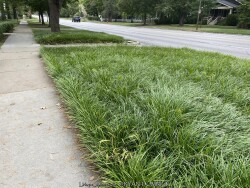

Big Blue Liriope (Liriope muscari 'Big Blue') grows to form a dense, dark green, grass-like groundcover in medium to full shade. As one of the very best "dry-shade" plants, it has environmental and economic traits that can help conserve water and lower your water bill! Plantings can thrive for decades if in the right spot; there is no such thing as overcrowding for Liriope. When planted in mass, growth is slow at first but eventually a cake-like rhizome system will form and completely smother out any weeds and compete well with trees for water and nutrients. Even under the most hostile conditions such as huge silver maple and pin oak trees, liriope not only survives but thrives. While Big Blue Liriope can tolerate full sun, they prefer part to full shade. Sun burning is possible with temperatures over 100° and there are better plants to use in hot areas. Liriope has no insect or disease problems, will survive droughts, short-term floods and cold winters. In the winter, it will stay green until 0 degrees F and be completely evergreen some winters. Liriope also thrives in summer with the worst heat and humidity even in the Southeast and Southwest! Liriope is tolerant of a wide range of soil types but prefers clay/loam and will display best growth in fertile soils with average water but extremely drought tolerant in shaded areas! For the home garden, the species spreads slowly so you shouldn't leave very much room in-between Liriope plants or you will be waiting many years for the patch to fill in. Weeds can be a problem in that open area between plants if spacing is too wide. We recommend 12-18" spacing for a larger area. The only problem we have seen is a mysterious crown-rot disease in well-irrigated gardens. This liriope (Liriope muscari 'Big Blue') does not spread very quickly or much at all compared to Spreading Liriope / Monkey Grass (Liriope spicata) This is a real trooper for the dry shade garden!


Liriope (Liriope spitica) grows to form a dense, dark green, grass-like groundcover / turf in medium to full shade. (also called "Lilyturf"). As one of the very best "dry-shade" plants, it has environmental and economic traits that cannot be disputed. A typical homeowner will save hundreds of dollars a year on lawn maintenance costs. Large turflike installations can save thousands of dollars per year. Even under the most hostile conditions such as huge silver maple and pin oak trees, liriope not only survives but thrives. Liriope has no insect or disease problems, will survive droughts, short-term floods and cold winters. Liriope has a very low water requirement and a deep root system that allows it to draw water from a large area. Liriope thrives on only 1 deep watering per month in the summer to stay green. In the winter, it will stay green until zero degrees and be completely evergreen some winters. If the top Liriope grows to form a dense groundcover / turf in medium to full shade. Liriope requires no mowing maintenance (monthly mowing is optional to achieve 4" height) Un-mowed, it will grow uniformly 8-10" and appear like a lawn from a distance. Fewer weed problems occur; the dense growth of liriope grass smothers out existing weeds and prevents the germination of new seeds. The soft texture and medium green color are great assets; evergreen to 0ºF, survives -20. Liriope grows in zones 5-9; tolerates cold in the winter and heat / humidity in the summer. Liriope is tolerant of a wide range of soil types but prefers clay/loam and will display best growth in fertile soils with average water but extremely drought tolerant in shaded areas! For the home garden, the species is generally too aggressive to mix with other plants. Use as a groundcover or lawn substitute for dry-shade.
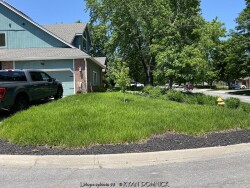

Liriope (Liriope spitica) grows to form a dense, dark green, grass-like groundcover / turf in medium to full shade. (also called "Lilyturf"). As one of the very best "dry-shade" plants, it has environmental and economic traits that cannot be disputed. A typical homeowner will save hundreds of dollars a year on lawn maintenance costs. Large turflike installations can save thousands of dollars per year. Even under the most hostile conditions such as huge silver maple and pin oak trees, liriope not only survives but thrives. Liriope has no insect or disease problems, will survive droughts, short-term floods and cold winters. Liriope has a very low water requirement and a deep root system that allows it to draw water from a large area. Liriope thrives on only 1 deep watering per month in the summer to stay green. In the winter, it will stay green until zero degrees and be completely evergreen some winters. If the top Liriope grows to form a dense groundcover / turf in medium to full shade. Liriope requires no mowing maintenance (monthly mowing is optional to achieve 4" height) Un-mowed, it will grow uniformly 8-10" and appear like a lawn from a distance. Fewer weed problems occur; the dense growth of liriope grass smothers out existing weeds and prevents the germination of new seeds. The soft texture and medium green color are great assets; evergreen to 0ºF, survives -20. Liriope grows in zones 5-9; tolerates cold in the winter and heat / humidity in the summer. Liriope is tolerant of a wide range of soil types but prefers clay/loam and will display best growth in fertile soils with average water but extremely drought tolerant in shaded areas! For the home garden, the species is generally too aggressive to mix with other plants. Use as a groundcover or lawn substitute for dry-shade.
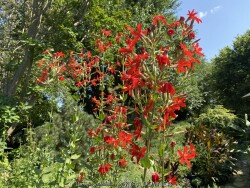

***Description for this perennial available with future update!***Cardinal Flower / Native Lobilia, is also known as Lobelia cardinalis


***Description for this perennial available with future update!*** Lobelia siphilitica 'Blue Select' is also known as Blue Select Great Blue Lobilia.
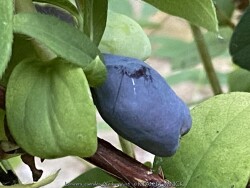

Also called Honeyberries, Japanese Haskap, or Yezberry® (Lonicera caerulea), these shrubs are easy-to-grow fruiting plants developed for their large, delicious blue fruit. Yezberry® Japanese haskaps are an easy-to-grow, super delicious fruit for everyone. Yellow flowers appear very early in spring (we'll bet it's the first thing to bloom in your yard each year) and give way to plump blue fruits in early summer. Berries are sweet enough to eat straight from the stems, or can be made into sauce, jam, or desserts. This tough shrub grows well in sun or part shade, and isn't fussy about soil: any type and even any pH level will do. Yezberry haskaps are extremely cold tolerant. Yezberry® Solo will bear fruit without a pollinator, but gets larger and more numerous berries when planted alongside another Yezberry® Japanese haskap variety. Yezberry® are extremely cold hardy and able to bear fruit in zones 3-7. However, as an ornamental shrub, late summer Kansas heat stress will likely cause partial to complete defoliation. This does not affect the fruit quality or overall health of the shrub as the flower buds for next year are already formed. Ultra cold-hardy plants from northern climates normally dislike our long hot humid summers; although we are on the Southern edge of this plants adaptability, it still survives reasonably well here. Look for a cold microclimate planting location such as East or North exposure. All Proven Winners® plants are legally propagated, healthy and vigorous, true to name, and tagged with color pictures and growing information.
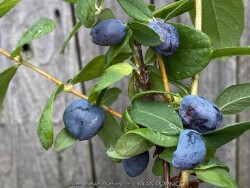

Also called Honeyberries, Japanese Haskap, or Yezberry® (Lonicera caerulea), these shrubs are easy-to-grow fruiting plants developed for their large, delicious blue fruit. Yezberry® are extremely cold hardy and able to bear fruit in zones 3-7. Plant with another Yezberry® variety for an abundant fruit set on both plants. However, as an ornamental shrub, late summer Kansas heat stress will likely cause partial to complete defoliation. This does not affect the fruit quality or overall health of the shrub as the flower buds for next year are already formed. Ultra cold-hardy plants from northern climates normally dislike our long hot humid summers; although we are on the Southern edge of this plants adaptability, it still survives reasonably well here. Look for a cold microclimate planting location such as East or North exposure. In Eastern Kansas, typically our 40 inches of rainfall is sufficient without extra water. All Proven Winners® plants are legally propagated, healthy and vigorous, true to name, and tagged with color pictures and growing information.
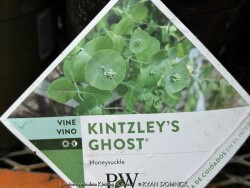

Kintzley’s Ghost Honeysuckle (Lonicera reticulata 'Kintzley’s Ghost') is a wild-looking plant is actually native to North America. Each season, it begins like any other honeysuckle, with typical dusty green leaves. As the season progresses, flower buds pop out like saucers. These rounded bracts look a lot like eucalyptus, but the flowers at the center feed native pollinators like hummingbirds! They turn into red berries in the fall, but won’t become a nuisance like other honeysuckles. Due to its size and interesting seasonal changes, it makes an incredible specimen.Top reasons to grow Kintzley’s Ghost honeysuckle. 1. A noninvasive native honeysuckle. 2. Interesting foliage, flower, and berry progression. 3.Tough landscape performance. We look forward to testing this variety in our zone 6 Lawrence, KS display garden... evaluation available with future update!
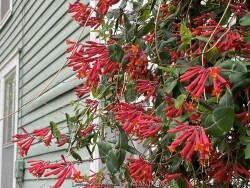

Coral Honeysuckle / American Honeysuckle (Lonicera sempervirens) is native to eastern North America. It is a vine planted for its blue-green oval shaped foliage and gorgeous reddish/pink/orange flowers. American Honeysuckle is normally used in the landscape to cover trellises, pergolas, fences, and trees. Mature vines, when allowed to climb, flower and provide a valuable food source for hummingbirds, butterflies and other birds. Grow in rich, well drained soils in part shade or full sun. Sometimes foliage persists well into fall as it is a semi-evergreen plant in the South. Other times, foliage becomes too bedraggled to be effective if summers are too hot and humid causing powdery mildew and leaf spots to occur. After establishment, most vines can be high maintenance if it has already filled the space and you don't want it to spread any further so plan accordingly. It will climb trees if you allow it to naturalize, generally using it for support and not injuring it. The growth and foliage prefers to stay within the shade of canopy not covering over it. For the home garden, the species is a great native alternative to invasive Asian and Japanese honeysuckles.
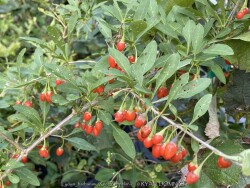

It's easy to grow your own goji berries! Though they seem like something exotic and tricky to grow, goji berries are durable, productive plants that can be grown without any special sprays, fertilizers, or even fussy pruning. Just plant them in full sun, stake them, and wait to reap a bounty of bright red fruits in autumn. Red Zeppelin® Goji Berry (Lycium barbarum 'Red Zeppelin') was selected especially for its very large fruit, which makes harvesting easier and more fun. A few things to note about growing goji berries: 1. they prefer an alkaline (higher pH) soil and don't grow well in acidic conditions. 2. goji has a natural habit of creating lots of thin, vine-like stems. To save space and make harvesting easier, we recommend that you put a very sturdy stake near the shrub after planting, then bundle the stems around the stake, tying with sturdy twine so that about one-quarter of the tops of the branches cascade downward, like a fountain. 3. Goji is generally a heavy feeder, and regular fertilizing is recommended. Apply a tomato or rose fertilizer in spring and again in early summer. The fruits are a bit bitter, like a green pepper, when they are fresh. To develop sweetness, they must be dried. If you don't have a dehydrator, spread ripe berries in a single layer on a piece of newspaper in a cool, bright spot with good air circulation. After about a week, they will feel leathery and can be stored in the fridge or freezer. Maintenance Notes: Does best in well-drained neutral to alkaline soils. At planting time, sink a 1x1" wood stake near the plant and bundle the canes around it. Let the tips of the stems cascade down, like a fountain. Each spring, move the tied point up further along the stake so that about one-quarter of the growth is above the tie. Then cut the branch tips back by 4-6". This encourages lateral branching, which is where most of the flowering and fruiting takes place. In Eastern Kansas, typically our 40 inches of rainfall is sufficient without extra water. All Proven Winners® plants are legally propagated, healthy and vigorous, true to name, and tagged with color pictures and growing information.
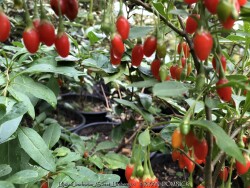

Gogi berries (Lycium barbarum) have purple flowers in mid-summer develop into jewel-like red fruits that are bitter and tomato-like when fresh but turn sweet when set out to dry for a week or so. Very high yielding, especially in alkaline soils. Sweet Lifeberry Gogi Berry (Lycium barbarum 'Sweet Lifeberry') was selected for its extra-sweet fruit which makes for easier harvesting. Maintenance Notes: Does best in well-drained neutral to slightly alkaline soils. At planting time, sink a 1x1" wood stake near the plant and bundle the canes around it. Let the tips of the stems cascade down, like a fountain. Each spring, move the tied point up further along the stake so that about one-quarter of the growth is above the tie. Then cut the branch tips back by 4-6". This encourages lateral branching, which is where most of the flowering and fruiting takes place. Grow superfruit in your own backyard! Fruits become especially sweet when dried. Goji berries are easy to grow in full sun, although some staking is recommended for maximum access to the nutrient-rich fruit. A pollinator is not needed. In Eastern Kansas, typically our 40 inches of rainfall is sufficient without extra water. All Proven Winners® plants are legally propagated, healthy and vigorous, true to name, and tagged with color pictures and growing information.
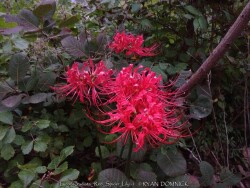

***Description for this plant available with future update!*** Lycoris radiata is also known as Red Suprise Lily / Red Spider Lily.
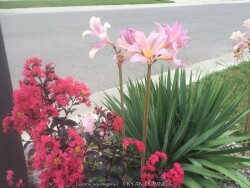

***Description for this perennial available with future update!*** Lycoris squamigera is also known as Pink Surprise Lily / Lycoris >>>>>>>>>>>>are typically grown for their mid-summer flowers and vertical iris-leaf foliage. The plants are temperate and subtropical herbaceous perennial bulbs native to areas with a summer wet season and dry winter. Gladiolus are hardy outside as a perennial when established and with minimal effort at least up to zone 6a. During the growing season, fertilize, water regularly, and plant in full sun. Plant these bulbs in the ground at least 6-8" deep with 3-4" of mulch to enjoy a wonderful tropical flowering effect! Foliage may look bedwraggled by fall so it is ok to cut back foliage at that time. They can also be grown as a flowering summer patio plant. If growing as a potted plant and trying to overwinter, allowing the foliage to frost is ok, it will not kill the root system. However, do not allow the pot with rootball to freeze solid or go below 20 degrees for more than a few hours; move into a cold garage or basement over the winter with no watering. Cut back and allow to go dormant and place entire pot back out in April or May with a time-release fertilizer. Another more labor intensive way to overwinter gladiolus is to remove them from the dirt, dust with fungicide, place in box with sawdust, and keep in the refrigerator. We consider this method old-fashioned and too much work but ok if you only want to save a few bulbs. If digging from the ground in colder zones, just save a big chunk with the dirt intact and place into a large pot in the garage. In a customer's garden in Lawrence, KS (zone 6a), four established specimens planted over 4-6" deep and mulched 2-3" with wood mulch survived -17 degrees F. During the arctic blast of February, 2021, lows down to -17 degrees F on Feb 16th, 2021 were recorded. The longevity of this cold blast was also impressive: 10 days on a row with highs of 10-15 degrees F or lower, 8 nights of lows in the single digits and negatives, and 36 straight hours of 0 degrees F and mostly lower.
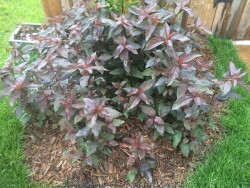

***Description for this perennial available with future update!*** Lysimachia ciliata 'Firecracker' is also known as Firecracker Purple-leaf Lysimachia.
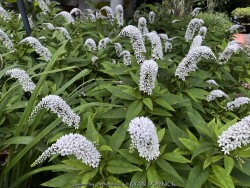

***Description for this perennial available with future update!*** Lysimachia clethroides is also known as White Gooseneck / Lysimachia >>>>>>>>>>>>For the home garden in rich well irrigated areas, this species can be too aggressive from self-seeding to mix with other plants. Use as a mass planting in poor un-irrigated soils only. However, in a difficult dry-shade garden, it will thrive, flower, and be relatively tame.>>>>>This plant can also be used as a marginal aquatic plant growing in shallow water. It can also grow as a bog plant needing constantly moist soil rich in organic matter. As a rain garden plant, it will thrive is a depressed area in the landscape that collects rain water from a roof during spring and summer periods of rain but then go dormant if the water hole dries out completely.
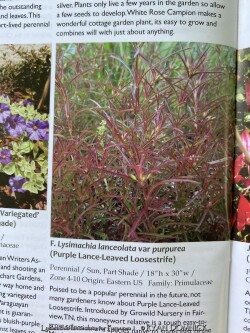

***Description for this perennial available with future update!*** Lysimachia lanceolata var. purpurea is also known as Purple Lance-Leaved Loosestrife.
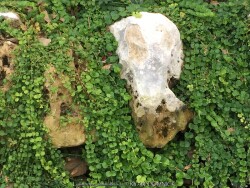

***Description for this perennial available with future update!*** Lysimachia nummularia is also known as Green Moneywort / Creeping Jenny >>>>>This plant can also be used as a marginal aquatic plant growing in shallow water. It can also grow as a bog plant needing constantly moist soil rich in organic matter. As a rain garden plant, it will thrive is a depressed area in the landscape that collects rain water from a roof during spring and summer periods of rain but then go dormant if the water hole dries out completely.
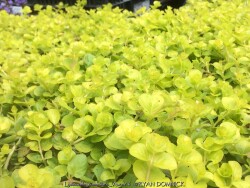

***Description for this perennial available with future update!*** Lysimachia nummularia 'Aurea' is also known as Gold Moneywort / Creeping Jenny >>>>>This plant can also be used as a marginal aquatic plant growing in shallow water. It can also grow as a bog plant needing constantly moist soil rich in organic matter. As a rain garden plant, it will thrive is a depressed area in the landscape that collects rain water from a roof during spring and summer periods of rain but then go dormant if the water hole dries out completely.>>>>> Ultra cold-hardy plants from northern climates normally dislike our long hot humid summers; although we are on the Southern edge of this plants adaptability, it still survives reasonably well here. Look for a cold microclimate planting location such as East or North exposure.>>>>>
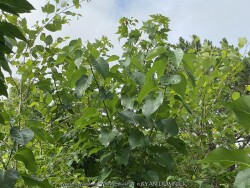

***Tree descriptions available with future update!***White Shield Fruitless-Thornless Osage Orange, is also known as Maclura pomifera 'White Shield'
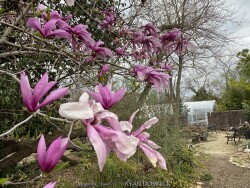

Jane Magenta Flowering Magnolia (Magnolia 'Jane'), noted for its compact, upright habit, grows best in organically rich, medium-moisture soil that's neutral to slightly acidic. Reddish purple flowers with white interiors open later in spring to avoid frost damage. Flowers do seem to tolerate light freezes down to 28 degrees that have occured here at our Lawrence, KS display garden without damage. Flowers are a gorgeous tulip shape with a lightly scented fragrance. Leaves are medium to dark green turning a beautiful gold in the fall. Jane magnolia makes a great understory small tree, specimen plant, or background shrub slowly growing 10'-15' high. Grows best in full morning sun and partially shaded afternoons in hot climates. Avoid hot West or South exposures and winds. Magnolias in general are a family of plants that have been around for millions of years and are among the most primitive of all flowers. In fact, most magnolia flowers evolved before bees and are thus pollinated by beetles. Magnolias generally grow in moist, well drained soils in sun or shade. They have no serious pests or disease problems. Occasionally seen listed as Magnolia liliflora 'Reflorescens' x stellate 'Waterlily'
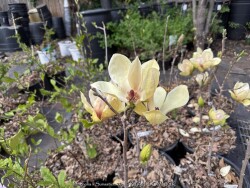

***Tree descriptions available with future update!*** Magnolia 'Sunsation' is also known as Sunsation Yellow Flowering Magnolia


Magnolia grandiflora 'Bracken's Brown Beauty' is one of the most cold hardy of the Southern Magnolias. Magnolias in general are a family of plants that have been around for millions of years and are among the most primitive of all flowers. In fact, most magnolia flowers evolved before bees and are thus pollinated by beetles. Magnolias generally have no serious pests or diseases. Any of the dwarf Southern Magnolia cultivars serve as a beautiful four seasons small tree or large shrub. Evergreen foliage is a shiny dark green with a brown-orange back that first emerges lighter green. If temperature stay above -10°F, foliage generally stays intact. If colder than that, it will shed its leaves like a deciduous tree when new growth occurs in April. Large tropical-looking white scented flowers bloom in late May and early June. Green cones, yes cones, follow in late summer with the cones opening up to yield beautiful red seeds. Seeds are viable but will not survive the winter here. Bracken's Brown Beauty Magnolias appreciate rich well-drained soil but will tolerate less than ideal clay soils. Sandy or rocky soils are tolerated if watering is sufficient. Magnolias can tolerate short periods of poor drainage but not consistent bog like conditions. Full sun is best but WELL-CARED for Magnolias can tolerate mostly shade in rich soils. This means do not use Magnolias under walnut trees, in dry shade, or exposed to north winds on the north side of a house. Being one of the few broadleaf evergreens hardy in zone 6, Bracken's Brown Beauty has many landscape uses. Several trees planted in a row or group will make an awesome wind and visual screen without the pest problems of coniferous evergreens. If ice or snow damage occurs, Magnolias have the ability to grow back reasonably quickly as opposed to most coniferous evergreens. In fact, Magnolias will come back from the ground is completely cut down and new growth from water sprouts will be rapid. Magnolias also make a great specimen tree or background for flowers and shrubs. Magnolias can be planted near a house without worrying about damaging root systems; they are very easily pruneable if they start getting too big. This highly-rated small landscape tree is perfect somewhere on your property!
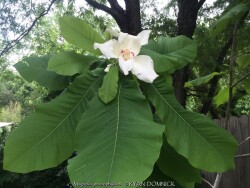

Bigleaf Magnolia (Magnolia macrophylla) features very large light green leaves that are the biggest simple leaf in North America measuring upto 36" long! They are native to pockets of the Appalachian mountains with perfect rich soils and protected from winds. One would think that plant like this would not do well in Kansas landscapes. However if given a little bit of wind protection, some watering, and decent soil, these trees will do fine and grow vigorously growing in sun or shade. Big leaf magnolias also produce large creamy white flowers and have silvery backs to their leaves adding to the appeal. With ideal conditions, a growth rate of 1 to 2 feet per year is possible. With more difficult conditions they will grow a few inches per year but still look attractive. There seems to be no other plant that can add a tropical feel like big leaf Magnolia. Magnolias in general are a family of plants that have been around for millions of years and are among the most primitive of all flowers. In fact, most magnolia flowers evolved before bees and are thus pollinated by beetles. Magnolias generally have no serious pests or diseases.


***Description for this plant available with future update!*** Magnolia x 'Felix' is also known as Felix Magnolia / Magenta-Pink Flowering Magnolia.


***Description for this plant available with future update!*** Magnolia x 'Genie' is also known as Genie Magnolia / Magenta Flowering Magnolia.


***Description for this plant available with future update!*** Magnolia x 'Vulcan' is also known as Vulcan Magnolia / Red-Magenta Flowering Magnolia.


Yellow Flowering Magnolia (Magnolia x brooklynensis 'Yellow Bird') is a rare jewel in the landscape: a tree with giant canary yellow flowers! Yellow Bird is an upright, conical to pyramidal, large deciduous tree that can grow 40 feet tall in Kansas. This magnolia would be a fine residential specimen in sheltered locations with moist, rich soil with plenty of space to spread. Magnolias in general are a family of plants that have been around for millions of years and are among the most primitive of all flowers. In fact, most magnolia flowers evolved before bees and are thus pollinated by beetles. Magnolias generally grow in moist, well drained soils in sun or shade. They have no serious pests or disease problems.
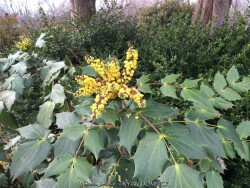

Leatherleaf Mahonia (Mahonia bealei) is a slow-growing coarse-textured evergreen shrub with bright green holly-like leaflets. The leaves are prickly and make a fine barrier or specimen plant. Native to continental climates in China, Mahonia bealei can be invasive in Eastern US woods where its shade tolerance and slow evergreen growth eventually shade out native plants. This is not a problem in Kansas due to extreme winters and dryer conditions. Flowering tries to occur in mid to late winter in Kansas but are usually frozen before they can open. During a "once in 5 years" mild winter if temperatures stay above 0 degrees F, fragrant, lemon-yellow flowers do develop. Even more rare is to have a long enough warm spell in winter to allow the beautiful blackish-blue fruit to develop afterward. If they do, they will be enjoyed by birds but any small seedlings that do germinate are killed by ground freezes the next winter. Leatherleaf Mahonia is very drought tolerant when established making it an ideal dry-shade plant; the 40 inches of typical rainfall in Eastern Kansas is sufficient if planted in rototilled soils. This could be one of the most cold-tolerant broadleaf evergreens available! It survived -16 degrees F and a week of single digit highs in February, 2021 with no damage. It even maintains bright green foliage in winter opposed to a dingy brownish-green like some evergreens. In Eastern Kansas, this species performs WELL with just about everything nature has to challenge it! Heat and drought are tolerated if in shade or morning sun. Cold tolerance is no problem. Invasiveness is not a problem. No disease or pest problems. And again, this is a great evergreen plant for difficult dry-shade situations under mature trees where lawn won't grow.
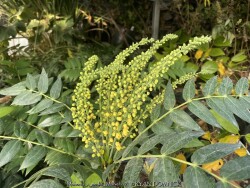

Leatherleaf Mahonia (Mahonia x media 'Marvel') is a slow-growing coarse-textured evergreen shrub with bright green holly-like leaflets. The leaves are prickly and make a fine barrier or specimen plant. Native to continental climates in China, Mahonia bealei can be invasive in Eastern US woods where its shade tolerance and slow evergreen growth eventually shade out native plants. This is not a problem in Kansas due to extreme winters and dryer conditions. Flowering tries to occur in mid to late winter in Kansas but are usually frozen before they can open. During a "once in 5 years" mild winter if temperatures stay above 0 degrees F, fragrant, lemon-yellow flowers do develop. Even more rare is to have a long enough warm spell in winter to allow the beautiful blackish-blue fruit to develop afterward. If they do, they will be enjoyed by birds but any small seedlings that do germinate are killed by ground freezes the next winter. Leatherleaf Mahonia is very drought tolerant when established making it an ideal dry-shade plant; the 40 inches of typical rainfall in Eastern Kansas is sufficient if planted in rototilled soils. This could be one of the more cold-tolerant broadleaf evergreens available! 'Marvel' survived -16 degrees F and a week of single digit highs in February, 2021 but with complete foliage loss. It even maintains bright green foliage in winter opposed to a dingy brownish-green like some evergreens. In Eastern Kansas, this species performs WELL with just about everything nature has to challenge it! Heat and drought are tolerated if in shade or morning sun. Cold tolerance is no problem. Invasiveness is not a problem. No disease or pest problems. And again, this is a great evergreen plant for difficult dry-shade situations under mature trees where lawn won't grow. Mahonia x media 'Marvel' is an improved cultivar that is more compact than other varieties. Evergreen foliage is a medium glossy green and more fine-textures compared to the species. Frond-like leaves develop in whorls and are arranged along coarsely branched stems creating an architectural effect. It is unknown at this point (2022) if flowers and fruit will develop here in Kansas zone 6a but it is doubtful seeing how it tries to bloom in the winter similar to the species.
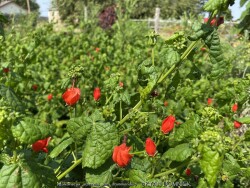

***Description for this hardy tropical available with future update!***Red Turk's Cap, is also known as Malvaviscus arboreus var. drummondii
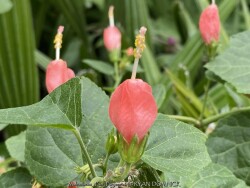

***Description for this hardy tropical available with future update!***Pink Turk's Cap, is also known as Malvaviscus drummondii 'Pam Puryear'
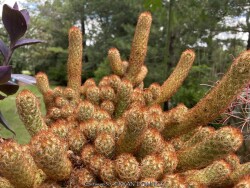

***Description for this plant available with future update!*** Mammillaria elongata ‘Copper King’ is also known as Copper King Lady Finger Cactus (Tropical)>>>>> Cacti are known for their spines, unusual shapes and beautiful flowers. Both succulents and cacti store water in their fleshy tissues. And can survive long periods without water. Cacti and succulents are usually grown as a deck/patio plant or house plant in Kansas. Grow in full sun with little to no extra watering except that which comes from rainfall. Generally, plants may be brought out in Late May through Early October in our zone 6a Lawrence, KS climate. To play is safe, potted plants are best moved in before autumn leaves begin to drop and before night temperatures get below 45 degrees F. It is very important to avoid the combination of wet and cold. Move to a bright interior window over the winter with little to no watering and keep above 50 degrees F. As a winter house plant, it will look presentable all winter long with little to no waterings. As a permanent house plant, provide bright light and allow the soil to dry completely between waterings and you will get many years of carefree enjoyment. Plants grown permanently indoors may eventually begin to elongate stretching for light and lose their spine color. It can be hard to reproduce the intense UV sunlight they need when growing indoors so moving outside for the summer is best. Generally if moving outside for the summer, allow 1-2 weeks of part shade or morning sun before placing in full sun. Plants with time to acclimate will thrive in full sun but be careful not to rush it or sunburning may occur. Repotting may or may not be needed depending on how large you want the plant to grow; plants can continue to grow taller and tolerate extremely root-bound pots but may need wind bracing. If repotting, make sure to use a sharp draining low organic cactus mix with plenty of sand and perlite but avoid peat moss. The “soil” most commercial cacti are potted in to too peaty and light weight. This soil becomes hydrophobic and shrinks after becoming bone dry and difficult to re wet again. Cacti never grow in peat-based soils in nature; this “Soil” is only good for shipping because of the light weight. Potted plants are very low maintenance but watch for scale and mealybugs that may hide beneath the cover of spines. The best pest removal approach is to periodically wash the cactus off. Achieve this with a water nozzle or hose breaker turned mostly off to increase the pressure from the blast of water. This high-pressured water kills the pests without damaging the thick cactus skin. Here are some little-known or rare factoids about cacti: 1. The "spines" are actually modified leaves filled with sap at first, then quickly drying out to form the spines! 2. Many cacti have bright colored flowers that mainly attract bees, while some tubular flowering types attract hummingbirds and bats. 3. Late on the evolutionary timeline, cacti fossils are rare to non-existent. Cacti are native almost exclusively to the Americas, while succulents can include a much larger plant palette be from any dry area in the world. 4. Some cactus plants have been known to survive more than 2 years without water. 5. Some cacti first evolved in a dry climate that later became wetter again. For example: several jungle species live as epiphytes in trees to achieve the fast drainage they need.
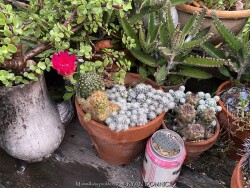

***Description for this plant available with future update!*** Mammillaria gracilis fragilis is also known as Thimble Cactus (Tropical)>>>>> Cacti are known for their spines, unusual shapes and beautiful flowers. Both succulents and cacti store water in their fleshy tissues. And can survive long periods without water. Cacti and succulents are usually grown as a deck/patio plant or house plant in Kansas. Grow in full sun with little to no extra watering except that which comes from rainfall. Generally, plants may be brought out in Late May through Early October in our zone 6a Lawrence, KS climate. To play is safe, potted plants are best moved in before autumn leaves begin to drop and before night temperatures get below 45 degrees F. It is very important to avoid the combination of wet and cold. Move to a bright interior window over the winter with little to no watering and keep above 50 degrees F. As a winter house plant, it will look presentable all winter long with little to no waterings. As a permanent house plant, provide bright light and allow the soil to dry completely between waterings and you will get many years of carefree enjoyment. Plants grown permanently indoors may eventually begin to elongate stretching for light and lose their spine color. It can be hard to reproduce the intense UV sunlight they need when growing indoors so moving outside for the summer is best. Generally if moving outside for the summer, allow 1-2 weeks of part shade or morning sun before placing in full sun. Plants with time to acclimate will thrive in full sun but be careful not to rush it or sunburning may occur. Repotting may or may not be needed depending on how large you want the plant to grow; plants can continue to grow taller and tolerate extremely root-bound pots but may need wind bracing. If repotting, make sure to use a sharp draining low organic cactus mix with plenty of sand and perlite but avoid peat moss. The “soil” most commercial cacti are potted in to too peaty and light weight. This soil becomes hydrophobic and shrinks after becoming bone dry and difficult to re wet again. Cacti never grow in peat-based soils in nature; this “Soil” is only good for shipping because of the light weight. Potted plants are very low maintenance but watch for scale and mealybugs that may hide beneath the cover of spines. The best pest removal approach is to periodically wash the cactus off. Achieve this with a water nozzle or hose breaker turned mostly off to increase the pressure from the blast of water. This high-pressured water kills the pests without damaging the thick cactus skin. Here are some little-known or rare factoids about cacti: 1. The "spines" are actually modified leaves filled with sap at first, then quickly drying out to form the spines! 2. Many cacti have bright colored flowers that mainly attract bees, while some tubular flowering types attract hummingbirds and bats. 3. Late on the evolutionary timeline, cacti fossils are rare to non-existent. Cacti are native almost exclusively to the Americas, while succulents can include a much larger plant palette be from any dry area in the world. 4. Some cactus plants have been known to survive more than 2 years without water. 5. Some cacti first evolved in a dry climate that later became wetter again. For example: several jungle species live as epiphytes in trees to achieve the fast drainage they need.
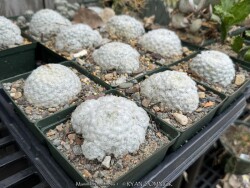

***Description for this plant available with future update!*** Mammillaria plumosa is also known as Feather Cactus (Tropical)>>>>> Cacti are known for their spines, unusual shapes and beautiful flowers. Both succulents and cacti store water in their fleshy tissues. And can survive long periods without water. Cacti and succulents are usually grown as a deck/patio plant or house plant in Kansas. Grow in full sun with little to no extra watering except that which comes from rainfall. Generally, plants may be brought out in Late May through Early October in our zone 6a Lawrence, KS climate. To play is safe, potted plants are best moved in before autumn leaves begin to drop and before night temperatures get below 45 degrees F. It is very important to avoid the combination of wet and cold. Move to a bright interior window over the winter with little to no watering and keep above 50 degrees F. As a winter house plant, it will look presentable all winter long with little to no waterings. As a permanent house plant, provide bright light and allow the soil to dry completely between waterings and you will get many years of carefree enjoyment. Plants grown permanently indoors may eventually begin to elongate stretching for light and lose their spine color. It can be hard to reproduce the intense UV sunlight they need when growing indoors so moving outside for the summer is best. Generally if moving outside for the summer, allow 1-2 weeks of part shade or morning sun before placing in full sun. Plants with time to acclimate will thrive in full sun but be careful not to rush it or sunburning may occur. Repotting may or may not be needed depending on how large you want the plant to grow; plants can continue to grow taller and tolerate extremely root-bound pots but may need wind bracing. If repotting, make sure to use a sharp draining low organic cactus mix with plenty of sand and perlite but avoid peat moss. The “soil” most commercial cacti are potted in to too peaty and light weight. This soil becomes hydrophobic and shrinks after becoming bone dry and difficult to re wet again. Cacti never grow in peat-based soils in nature; this “Soil” is only good for shipping because of the light weight. Potted plants are very low maintenance but watch for scale and mealybugs that may hide beneath the cover of spines. The best pest removal approach is to periodically wash the cactus off. Achieve this with a water nozzle or hose breaker turned mostly off to increase the pressure from the blast of water. This high-pressured water kills the pests without damaging the thick cactus skin. Here are some little-known or rare factoids about cacti: 1. The "spines" are actually modified leaves filled with sap at first, then quickly drying out to form the spines! 2. Many cacti have bright colored flowers that mainly attract bees, while some tubular flowering types attract hummingbirds and bats. 3. Late on the evolutionary timeline, cacti fossils are rare to non-existent. Cacti are native almost exclusively to the Americas, while succulents can include a much larger plant palette be from any dry area in the world. 4. Some cactus plants have been known to survive more than 2 years without water. 5. Some cacti first evolved in a dry climate that later became wetter again. For example: several jungle species live as epiphytes in trees to achieve the fast drainage they need.
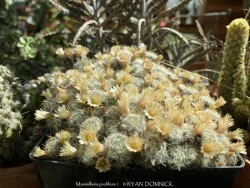

***Description for this plant available with future update!*** Mammillaria prolifera is also known as Texas nipple cactus (Tropical)>>>>> Cacti are known for their spines, unusual shapes and beautiful flowers. Both succulents and cacti store water in their fleshy tissues. And can survive long periods without water. Cacti and succulents are usually grown as a deck/patio plant or house plant in Kansas. Grow in full sun with little to no extra watering except that which comes from rainfall. Generally, plants may be brought out in Late May through Early October in our zone 6a Lawrence, KS climate. To play is safe, potted plants are best moved in before autumn leaves begin to drop and before night temperatures get below 45 degrees F. It is very important to avoid the combination of wet and cold. Move to a bright interior window over the winter with little to no watering and keep above 50 degrees F. As a winter house plant, it will look presentable all winter long with little to no waterings. As a permanent house plant, provide bright light and allow the soil to dry completely between waterings and you will get many years of carefree enjoyment. Plants grown permanently indoors may eventually begin to elongate stretching for light and lose their spine color. It can be hard to reproduce the intense UV sunlight they need when growing indoors so moving outside for the summer is best. Generally if moving outside for the summer, allow 1-2 weeks of part shade or morning sun before placing in full sun. Plants with time to acclimate will thrive in full sun but be careful not to rush it or sunburning may occur. Repotting may or may not be needed depending on how large you want the plant to grow; plants can continue to grow taller and tolerate extremely root-bound pots but may need wind bracing. If repotting, make sure to use a sharp draining low organic cactus mix with plenty of sand and perlite but avoid peat moss. The “soil” most commercial cacti are potted in to too peaty and light weight. This soil becomes hydrophobic and shrinks after becoming bone dry and difficult to re wet again. Cacti never grow in peat-based soils in nature; this “Soil” is only good for shipping because of the light weight. Potted plants are very low maintenance but watch for scale and mealybugs that may hide beneath the cover of spines. The best pest removal approach is to periodically wash the cactus off. Achieve this with a water nozzle or hose breaker turned mostly off to increase the pressure from the blast of water. This high-pressured water kills the pests without damaging the thick cactus skin. Here are some little-known or rare factoids about cacti: 1. The "spines" are actually modified leaves filled with sap at first, then quickly drying out to form the spines! 2. Many cacti have bright colored flowers that mainly attract bees, while some tubular flowering types attract hummingbirds and bats. 3. Late on the evolutionary timeline, cacti fossils are rare to non-existent. Cacti are native almost exclusively to the Americas, while succulents can include a much larger plant palette be from any dry area in the world. 4. Some cactus plants have been known to survive more than 2 years without water. 5. Some cacti first evolved in a dry climate that later became wetter again. For example: several jungle species live as epiphytes in trees to achieve the fast drainage they need.
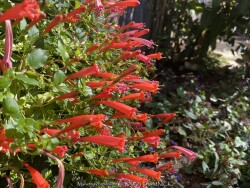

***Description for this plant available with future update!*** Manettia cordifolia is also known as Red Firecracker Vine.
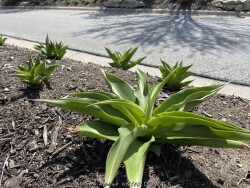

Hardy Manfreda (Manfreda virginica) are cute succulent perennials resembling a dwarf agave. The attractive green leaves are thick and fleshy with maroon spots extending to a point with a soft tip. Unusual, greenish-white, tubular flowers with conspicuous stamens are borne in a spike-like cluster atop 3-4' tall stalks. Some people prefer to trim the flowers for a more neat, compact look. Manfreda plants (also called American aloe) are native to eastern woods of Missouri, Oklahoma, Texas, Arkansas and much of the Southeast United States. This cold hardy succulent occupies an unusual niche: growing in poor shallow sandstone based soils in open woods and on sunny rock cliffs that dry out too quickly for most other plants to colonize. A good question is how does it find such isolated areas to colonize in the first place? Seeds are produced but do not spread far. Grow this small native gem in rock gardens, dry shade areas, in parking lot medians, in cracks between rocks, or on top of or in a retaining wall. It will re-seed to thicken the colony but only germinate in bare thin soils with no mulch. It will not tolerate competition in rich moist soils as other plants (or weeds) will shade it out. Most rock garden plants do not thrive indoors; aphids and spider mites seem to find them after a few months but overwintering indoors in a cool environment may work. If grown in pots and kept on the dry side, you may leave out all winter allowing to freeze solid; plants will go completely dormant and resume growth in the spring. Great low maintenance cold hardy succulent.
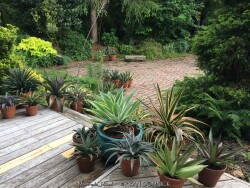

The variety of foliage colors and patterns make Mangave excellent architectural specimen plants. Mangave is a relatively new phenomenon, as a cross between the genus Manfreda and Agave. These rare hybrids combine the best of both worlds: the better growth rate and the interesting patterns of Manfreda, and the habit and refinement of Agave. Usually used as a patio or house plant in Kansas, they can also be grown as an annual. Grow in full sun to part sun with optional extra watering including that which comes from rainfall. Plants with time to acclimate will thrive in full sun but be careful not to rush it or sunburning will occur. Generally if moving outside for the summer, allow 2-3 weeks of part shade or morning sun before placing in full sun. Repotting may or may not be needed depending on how large you want the plant to grow; plants can continue to grow and tolerate extremely root-bound pots. Protect from temperatures below 35 degrees F and move into a bright window over the winter with no watering. Do not allow Mangave in pots to freeze solid or get close to freezing especially if soil is wet or death may occur. As a winter house plant, it will look presentable all winter long with just a few monthly or no waterings if you forget. As a permanent house plant, provide bright light and allow the soil to dry between waterings for many years of carefree enjoyment. Potted plants are very low maintenance needing only old leaves trimmed once per year. This is not at all a big-box store plant so be prepared to expand your plant palette with Mangave!
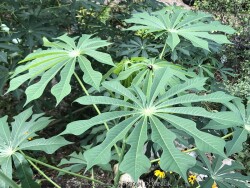

Hardy Tapioca (Manihot grahamii) is typically grown in warmer zones as a shrub or tree in the family Euphorbiaceae native to South America. Along with other tropicals and succulents in Kansas, hardy tapioca is usually grown as summer patio plant with amazing artistically whorled green leaves and small yellow flowers loved by bees. Water regularly and place in full sun or part shade. Protect from temperatures below 20 degrees F and move into a cold garage or basement over the winter with minimal watering. Do not allow the pot with rootball to freeze solid or go below 15 degrees for more than a few hours. Allow to go dormant as needed with little care, just cut off dead foliage/twigs and place back out in April or May with a time-release fertilizer. You may also propagate this plant easily by cutting off dormant twigs/branches and stuffing them into the ground. Notice that I didnt say rooting hormone or even being carefull was necessary! Landscapers also plant these as an annual in the ground for an enormous tropical effect with growth reaching 5-8' in one season from a 1gal container! It is possible to overwinter Manihot grahamii in the ground in Kansas as a woody perennial. In our trial gardens in Lawrence, KS (zone 6a), a one year established specimen planted on the South side of a house protected from winter moisture and mulched 12" thick with leaf mulch survived -17 degrees F. During the arctic blast of February, 2021, lows down to -17 degrees F on Feb 16th, 2021 were recorded. The longevity of this cold blast was also impressive: 10 days on a row with highs of 10-15 degrees F or lower, 8 nights of lows in the single digits and negatives, and 36 strait hours of 0 degrees F and mostly lower.
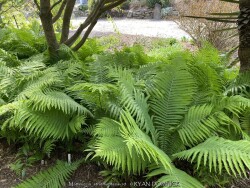

Ostrich Fern (Matteuccia struthiopteris) is planted for its graceful long bright green fronds reaching up to 3' in cultivation. Foliage maintains well all summer provided that certain cultural conditions are met. Native to eastern North America, Europe, eastern Asia, eastern North America, it colonizes forests and can be aggressive in ideal locations but not so much in Kansas. It can spread rapidly in humusy, medium well-drained soil in part shade to full shade. It cannot handle prolonged Kansas droughts or dry-shade. Foliage will flatten to the ground during breif drought then spring back up when moisture is available again. Generally however, in non-irrigated or poor soil areas, this plant will decline and allow weeds to invade. Perfect in wet shade areas, north walls, areas without tree-root competition, or shaded rain gardens. Ultra cold-hardy plants from northern climates normally dislike our long hot humid summers; although we are on the Southern edge of this plants adaptability, it still survives reasonably well here. Look for a cold microclimate planting location such as East or North exposure.
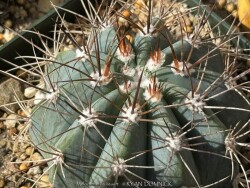

***Description for this plant available with future update!*** Melocactus azureus is also known as Blue Turk's Cap Cactus (Tropical)>>>>> Cacti are known for their spines, unusual shapes and beautiful flowers. Both succulents and cacti store water in their fleshy tissues. And can survive long periods without water. Cacti and succulents are usually grown as a deck/patio plant or house plant in Kansas. Grow in full sun with little to no extra watering except that which comes from rainfall. Generally, plants may be brought out in Late May through Early October in our zone 6a Lawrence, KS climate. To play is safe, potted plants are best moved in before autumn leaves begin to drop and before night temperatures get below 45 degrees F. It is very important to avoid the combination of wet and cold. Move to a bright interior window over the winter with little to no watering and keep above 50 degrees F. As a winter house plant, it will look presentable all winter long with little to no waterings. As a permanent house plant, provide bright light and allow the soil to dry completely between waterings and you will get many years of carefree enjoyment. Plants grown permanently indoors may eventually begin to elongate stretching for light and lose their spine color. It can be hard to reproduce the intense UV sunlight they need when growing indoors so moving outside for the summer is best. Generally if moving outside for the summer, allow 1-2 weeks of part shade or morning sun before placing in full sun. Plants with time to acclimate will thrive in full sun but be careful not to rush it or sunburning may occur. Repotting may or may not be needed depending on how large you want the plant to grow; plants can continue to grow taller and tolerate extremely root-bound pots but may need wind bracing. If repotting, make sure to use a sharp draining low organic cactus mix with plenty of sand and perlite but avoid peat moss. The “soil” most commercial cacti are potted in to too peaty and light weight. This soil becomes hydrophobic and shrinks after becoming bone dry and difficult to re wet again. Cacti never grow in peat-based soils in nature; this “Soil” is only good for shipping because of the light weight. Potted plants are very low maintenance but watch for scale and mealybugs that may hide beneath the cover of spines. The best pest removal approach is to periodically wash the cactus off. Achieve this with a water nozzle or hose breaker turned mostly off to increase the pressure from the blast of water. This high-pressured water kills the pests without damaging the thick cactus skin. Here are some little-known or rare factoids about cacti: 1. The "spines" are actually modified leaves filled with sap at first, then quickly drying out to form the spines! 2. Many cacti have bright colored flowers that mainly attract bees, while some tubular flowering types attract hummingbirds and bats. 3. Late on the evolutionary timeline, cacti fossils are rare to non-existent. Cacti are native almost exclusively to the Americas, while succulents can include a much larger plant palette be from any dry area in the world. 4. Some cactus plants have been known to survive more than 2 years without water. 5. Some cacti first evolved in a dry climate that later became wetter again. For example: several jungle species live as epiphytes in trees to achieve the fast drainage they need.
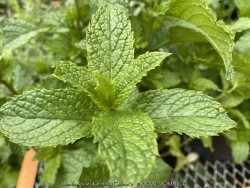

***Description for this perennial available with future update!*** Mentha spicata 'Kentucky Colonel' is also known as Kentucky Colonel Improved Mint >>>>>This plant can also be used as a marginal aquatic plant growing in shallow water. It can also grow as a bog plant needing constantly moist soil rich in organic matter. As a rain garden plant, it will thrive is a depressed area in the landscape that collects rain water from a roof during spring and summer periods of rain but then go dormant if the water hole dries out completely.>>>>>For the home garden, the species is generally too aggressive to mix with other plants>>>>>>>>>Also known as "Kentucky Colonel" mint, this hybrid of applemint (Mentha suaveolens) and true spearmint (M. spicata) has a wonderful fruity spearmint aroma and flavour. >>>>>>>>>>>>>>>>>>>>Its improved disease resistance and high yields make it a popular choice for commercial cultivation. >>>>>>>>>>>>>>>>The vigorous tendencies of mints allow them to be cut more frequently than most other herbs, growing back to a useful stage rapidly. For the home grower they are perfect for cultivation in large pots, where their tendency to march out of the garden and into the lawn can be restrained.
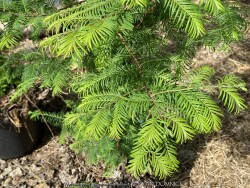

***Tree descriptions available with future update!***Dawn Redwood, is also known as Metasequoia glyptostroboides
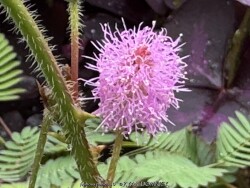

***Description for this plant available with future update!*** Mimosa pudica is also known as Sensitive Plant Mimosa (Tropical).
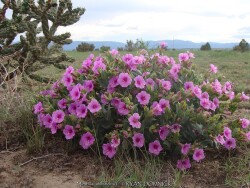

Wild Perennial Four O'Clock (Mirabilis multiflora) is a beautiful mound-forming native wildflower found from Texas, New Mexico, Colorado, and West to California. Flowers, born over a long period, are bright pink with a magenta center. Foliage is an attractive mint green to grey-green with hints of pink on new growth. This tap-rooted herbaceous perennial can grow up to 2 feet tall and 6 feet across but completely dies back in the fall and does not root as it spreads. A mature plant can have hundreds of flowers blooming at the same time! Flowers last only 1 day but more will follow tthe next day. Self-seeding is rare in our Kansas display garden. Typical landscape uses in Kansas are as follows: annual plantings, parking lot islands, hot West and South exposures, south facing berms, and xeriscape gardens. It will thrive in most soils but not poor drainage. Having desert heritage, it resents poor drainage and winter moisture. To counteract that in Kansas, plant in full sun on berm or south-facing wall with poor sandy or rocky soil with no irrigation. It would be very useful as a vine-like perennial cascading over the top of a retaining wall! Amazing that a perennial native to areas receiving 4-10" of rain per year can grow in a climate receiving 4-10 times more rain!